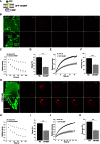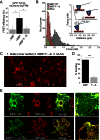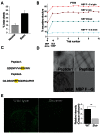Myelin membrane assembly is driven by a phase transition of myelin basic proteins into a cohesive protein meshwork
- PMID: 23762018
- PMCID: PMC3676292
- DOI: 10.1371/journal.pbio.1001577
Myelin membrane assembly is driven by a phase transition of myelin basic proteins into a cohesive protein meshwork
Abstract
Rapid conduction of nerve impulses requires coating of axons by myelin. To function as an electrical insulator, myelin is generated as a tightly packed, lipid-rich multilayered membrane sheath. Knowledge about the mechanisms that govern myelin membrane biogenesis is required to understand myelin disassembly as it occurs in diseases such as multiple sclerosis. Here, we show that myelin basic protein drives myelin biogenesis using weak forces arising from its inherent capacity to phase separate. The association of myelin basic protein molecules to the inner leaflet of the membrane bilayer induces a phase transition into a cohesive mesh-like protein network. The formation of this protein network shares features with amyloid fibril formation. The process is driven by phenylalanine-mediated hydrophobic and amyloid-like interactions that provide the molecular basis for protein extrusion and myelin membrane zippering. These findings uncover a physicochemical mechanism of how a cytosolic protein regulates the morphology of a complex membrane architecture. These results provide a key mechanism in myelin membrane biogenesis with implications for disabling demyelinating diseases of the central nervous system.
Conflict of interest statement
The authors have declared that no competing interests exist.
Figures






Similar articles
-
Myelin architecture: zippering membranes tightly together.Cell Mol Life Sci. 2014 Apr;71(7):1265-77. doi: 10.1007/s00018-013-1492-0. Epub 2013 Oct 29. Cell Mol Life Sci. 2014. PMID: 24165921 Free PMC article. Review.
-
Membrane Association Landscape of Myelin Basic Protein Portrays Formation of the Myelin Major Dense Line.Sci Rep. 2017 Jul 10;7(1):4974. doi: 10.1038/s41598-017-05364-3. Sci Rep. 2017. PMID: 28694532 Free PMC article.
-
Ionic strength and calcium regulate membrane interactions of myelin basic protein and the cytoplasmic domain of myelin protein zero.Biochem Biophys Res Commun. 2019 Mar 26;511(1):7-12. doi: 10.1016/j.bbrc.2019.02.025. Epub 2019 Feb 10. Biochem Biophys Res Commun. 2019. PMID: 30755303
-
Structural and dynamical properties of reconstituted myelin sheaths in the presence of myelin proteins MBP and P2 studied by neutron scattering.Soft Matter. 2014 Jan 21;10(3):519-29. doi: 10.1039/c3sm51393a. Soft Matter. 2014. PMID: 24651633
-
Central nervous system myelin: structure, function, and pathology.Clin Biochem. 1991 Apr;24(2):113-34. doi: 10.1016/0009-9120(91)90421-a. Clin Biochem. 1991. PMID: 1710177 Free PMC article. Review.
Cited by
-
SHANK3 deficiency leads to myelin defects in the central and peripheral nervous system.Cell Mol Life Sci. 2022 Jun 20;79(7):371. doi: 10.1007/s00018-022-04400-4. Cell Mol Life Sci. 2022. PMID: 35726031 Free PMC article.
-
Myelin architecture: zippering membranes tightly together.Cell Mol Life Sci. 2014 Apr;71(7):1265-77. doi: 10.1007/s00018-013-1492-0. Epub 2013 Oct 29. Cell Mol Life Sci. 2014. PMID: 24165921 Free PMC article. Review.
-
Oligodendrocytes in a Nutshell.Front Cell Neurosci. 2015 Sep 1;9:340. doi: 10.3389/fncel.2015.00340. eCollection 2015. Front Cell Neurosci. 2015. PMID: 26388730 Free PMC article. Review.
-
A unified cell biological perspective on axon-myelin injury.J Cell Biol. 2014 Aug 4;206(3):335-45. doi: 10.1083/jcb.201404154. J Cell Biol. 2014. PMID: 25092654 Free PMC article. Review.
-
Myelin membrane wrapping of CNS axons by PI(3,4,5)P3-dependent polarized growth at the inner tongue.Cell. 2014 Jan 16;156(1-2):277-90. doi: 10.1016/j.cell.2013.11.044. Cell. 2014. PMID: 24439382 Free PMC article.
References
-
- Hyman AA, Simons K (2012) Beyond oil and water-phase transitions in cells. Science 337: 1047–1049. - PubMed
-
- Weber Stephanie C, Brangwynne Clifford P (2012) Getting RNA and protein in phase. Cell 149: 1188–1191. - PubMed
-
- Brangwynne CP, Eckmann CR, Courson DS, Rybarska A, Hoege C, et al. (2009) Germline P granules are liquid droplets that localize by controlled dissolution/condensation. Science 324: 1729–1732. - PubMed
-
- Emery B (2010) Regulation of oligodendrocyte differentiation and myelination. Science 330: 779–782. - PubMed
Publication types
MeSH terms
Substances
LinkOut - more resources
Full Text Sources
Other Literature Sources

